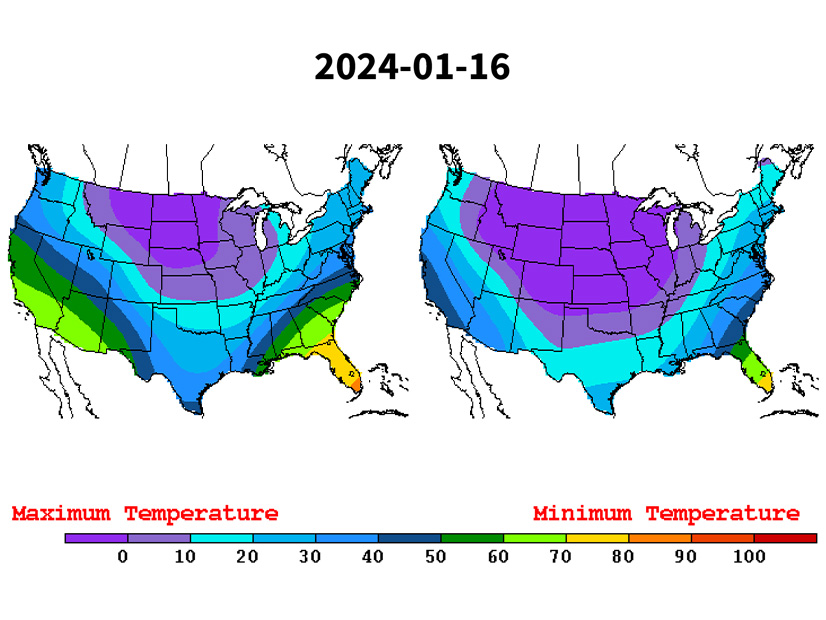
The North American electric and natural gas systems survived this year’s Arctic storms with no major incidents, demonstrating significant progress from the performance issues in previous severe winter events, FERC and NERC staff said at the commission’s open meeting this week.
However, the presenters said there still is considerable room for improvement and both industries continue to face challenges from extreme cold weather and the impacts of climate change.
The winter storms, also known as Gerri and Heather, began on Jan. 10, according to Chanel Chasanov from FERC’s Office of the General Counsel. Gerri entered the picture first, moving through the Pacific Northwest, across the Rocky Mountains and into the Midwest, and then up through the Great Lakes region and into southern Canada on Jan. 13. That same day, Heather developed, also beginning in the Pacific Northwest but taking “a more southern route” through Texas, Oklahoma and Tennessee before sweeping into the Mid-Atlantic and ending in Canada on Jan. 17.
Both Gerri and Heather brought “frigid cold, high winds, heavy snow and in some places freezing precipitation,” Chasanov said. But while the cold weather caused some challenges to gas and electric reliability, there was no operator-initiated load shed and generators reported fewer derates and outages than in other recent cold weather events such as winter storm Uri in 2021 and 2022’s Winter Storm Elliott.
FERC, NERC and the regional entities launched a review in February of the electric grid and natural gas system’s performance during Gerri and Heather in order to determine the progress made since the “unacceptable” performance during Elliott. (See FERC-NERC Elliott Report Calls Winter Outages ‘Unacceptable’.) Chasanov said that because there were no major incidents to focus on, the team chose “a more qualitative approach” informed mainly by voluntary interviews with grid operators and staff presentations than the quantitative approach favored in previous years.
The report found that conditions during the storms generally were less severe than those seen in Uri and Elliott, which contributed to the system’s performance. For example, entities encountered less freezing precipitation than in the previous incidents and did not see wind turbine blades ice up to the extent they did in Elliott.
However, presenters noted that the hardest-hit area in January was the Pacific Northwest, where Chasanov said winters typically are mild and utilities “had limited operational experience in dealing with these … conditions” compared to their counterparts in the Eastern Interconnection. Entities in this region reported the temperatures of Gerri and Heather represented a “one-in-30-years cold event,” with record lows experienced in parts of Oregon and Washington.
Matt Lewis, NERC’s manager of event analysis, said “neighboring reliability coordinators and balancing authorities worked closely” on their winter response measures before and during the storms, holding daily conference calls beginning seven days before the onset of severe weather.
“These entities noted that this practice provided a higher level of situational awareness than they experienced during Uri and Elliott and improved their ability to make more informed reliability decisions,” Lewis said. “Additionally, based on lessons learned, one grid operator’s executive team met daily during Gerri and Heather to communicate operating plans … from staff [in] generation and transmission operations to the control center in natural gas scheduling.”
Robert Clark from FERC’s Office of Electric Reliability said the performance of the natural gas system “validates the important recommendations and lessons learned from” the reports on Uri and Elliott, as well as the joint report on black-start resource availability released last December. (See FERC Black Start Report Pushes Gas-electric Coordination.)
While the storms “triggered a rise in natural gas demand, coupled with a nearly simultaneous plummet in … production” as seen in previous events, Clark said gas entities proactively reached out to the public to communicate current operating conditions and appeal for conservation. Utilities also worked to prevent outages by increasing pipeline pressures ahead of time to ensure the presence of gas where needed, including for electric generation.
“The natural gas system experienced fewer disruptions during Gerri and Heather as compared to Uri and Elliott,” but the experience of January “demonstrated the benefit of advanced preparations, diversity of natural gas supplies, [and] natural gas storage and reinforce the need to continue implementing the recommendations from” previous reports, Clark said.
FERC Chair Willie Phillips thanked the presenters, joking that the positive news allowed him to wear his “happy face,” rather than the “determined face” he used for previous winter storm reports. He emphasized that winter preparedness “remains a priority” for the commission and called for stakeholders to continue implementing the recommendations issued after Uri and Elliott, while reiterating his support for an organization to ensure reliability in the natural gas industry.
In a statement, NERC CEO Jim Robb said the report indicated “the industry prepared and got ready for the Arctic cold” ahead of January’s storms.
“I am confident that the winter reliability requirements in [NERC’s] cold weather standards are providing clarity and the winter preparation support NERC and the regional entities are providing is making a difference in generation performance during cold weather events, but as the chairman notes, there is still much left to do,” Robb added.

